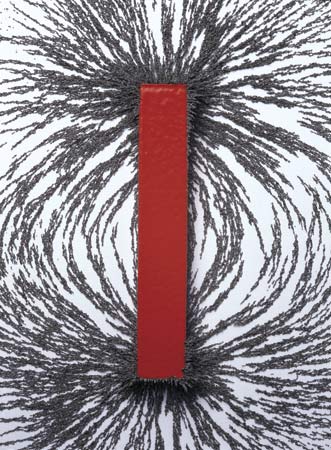 A freely moving magnet comes to rest pointing in a north-south direction
A freely moving magnet comes to rest pointing in a north-south direction
 All magnets have a magnetic north-seeking pole and south-seeking pole
All magnets have a magnetic north-seeking pole and south-seeking pole
 The area around a magnet where a magnetic material would experience a pulling force is called a magnetic field
The area around a magnet where a magnetic material would experience a pulling force is called a magnetic field
 The magnetic field around magnets ca
The magnetic field around magnets ca n be shown using iron filings
n be shown using iron filings
 The magnetic field line patterns show the relative strength of magnetic fields - close lines means a strong field.
The magnetic field line patterns show the relative strength of magnetic fields - close lines means a strong field.
 The direction of the magnetic field can be plotted using compasses
The direction of the magnetic field can be plotted using compasses
 The magnetic field lines show the direction of the magnetic field
The magnetic field lines show the direction of the magnetic field
 Magnets attract only the magnetic materials: iron, nickel and cobalt (not other metals) and their alloys (a metal that has a mixture of metal atoms in it) such as steel or compounds such as magnetic iron oxide
Magnets attract only the magnetic materials: iron, nickel and cobalt (not other metals) and their alloys (a metal that has a mixture of metal atoms in it) such as steel or compounds such as magnetic iron oxide
 The like (same) poles of a magnet repel and unlike poles attract
The like (same) poles of a magnet repel and unlike poles attract
 Repulsion is the only test of a magnet because magnets do attract other magnets opposite poles but also other magnetic materials but the only thing they will repel is the like pole of another magnet!
Repulsion is the only test of a magnet because magnets do attract other magnets opposite poles but also other magnetic materials but the only thing they will repel is the like pole of another magnet!
 Magnetic forces 'act through' non-magnetic materials but not through magnetic materials - so magnetic materials can be used as a shield around a magnet.
Magnetic forces 'act through' non-magnetic materials but not through magnetic materials - so magnetic materials can be used as a shield around a magnet.
 Magnetic materials can be made into magnets by stroking them with the pole of a magnet
Magnetic materials can be made into magnets by stroking them with the pole of a magnet
 Magnetism can be destroyed by 'bashing', heating or an a.c. current in a coil
Magnetism can be destroyed by 'bashing', heating or an a.c. current in a coil

 The domain theory of magnetism tries to explain why metals get magnetised. The magnetic elements have little molecular magnets inside them. These are randomly orientated in an unmagnetized piece of metal but point in a particular direction in a magnetised piece.
The domain theory of magnetism tries to explain why metals get magnetised. The magnetic elements have little molecular magnets inside them. These are randomly orientated in an unmagnetized piece of metal but point in a particular direction in a magnetised piece.
The difference between soft and hard magnetic materials -
 Soft magnetic materials (e.g. iron) have domains that easily move into line when the metal is placed in a magnetic field but as soon as the field is removed the domains take on a random pattern again. It returns to being unmagnetized straight away.
Soft magnetic materials (e.g. iron) have domains that easily move into line when the metal is placed in a magnetic field but as soon as the field is removed the domains take on a random pattern again. It returns to being unmagnetized straight away.
 Hard magnetic materials (e.g. steel) have domains that do not easily move into line when the metal is placed in a magnetic field, a strong field is needed for some time, but then, when the field is removed the domains retain the magnetic pattern. The metal stays magnetic for a long time.
Hard magnetic materials (e.g. steel) have domains that do not easily move into line when the metal is placed in a magnetic field, a strong field is needed for some time, but then, when the field is removed the domains retain the magnetic pattern. The metal stays magnetic for a long time.

